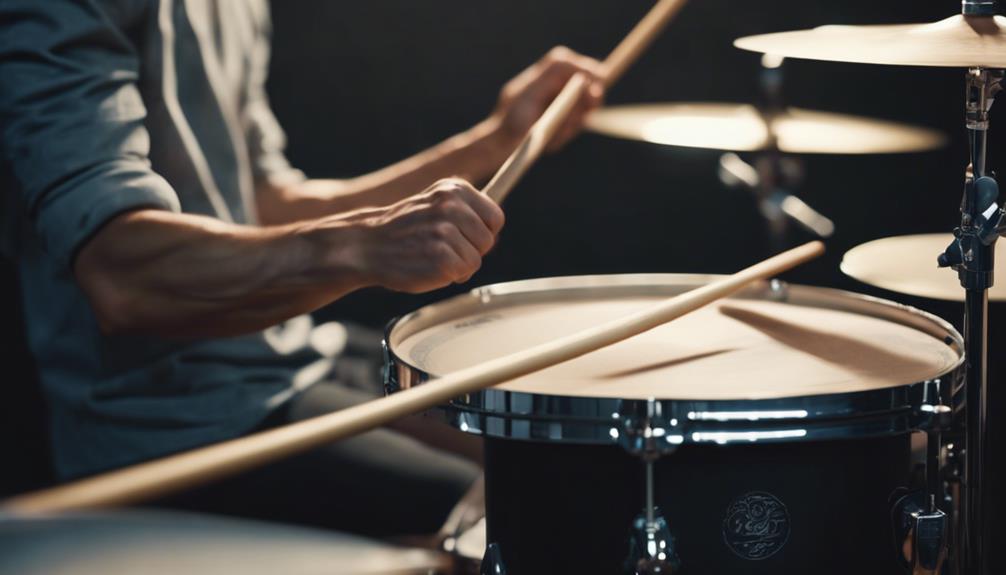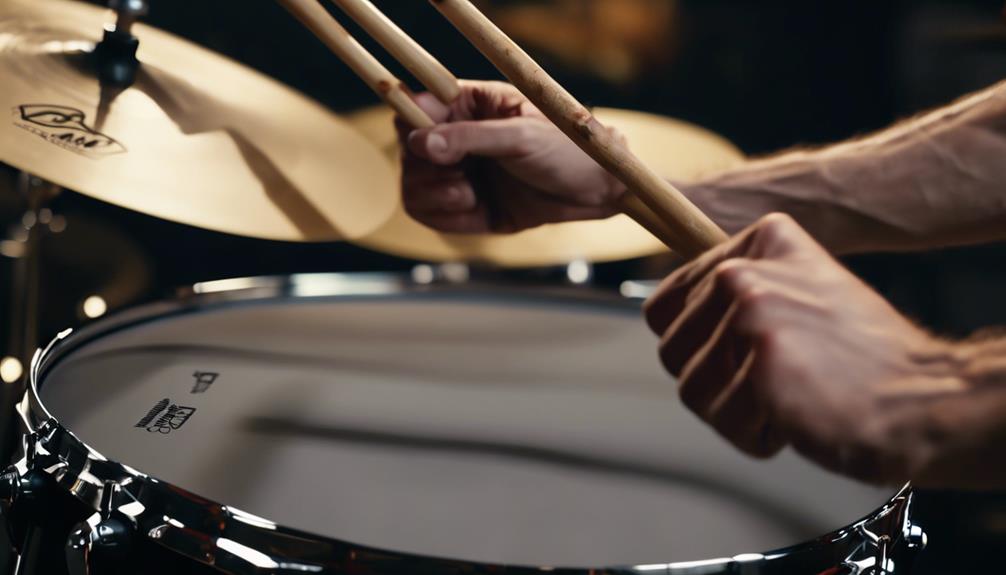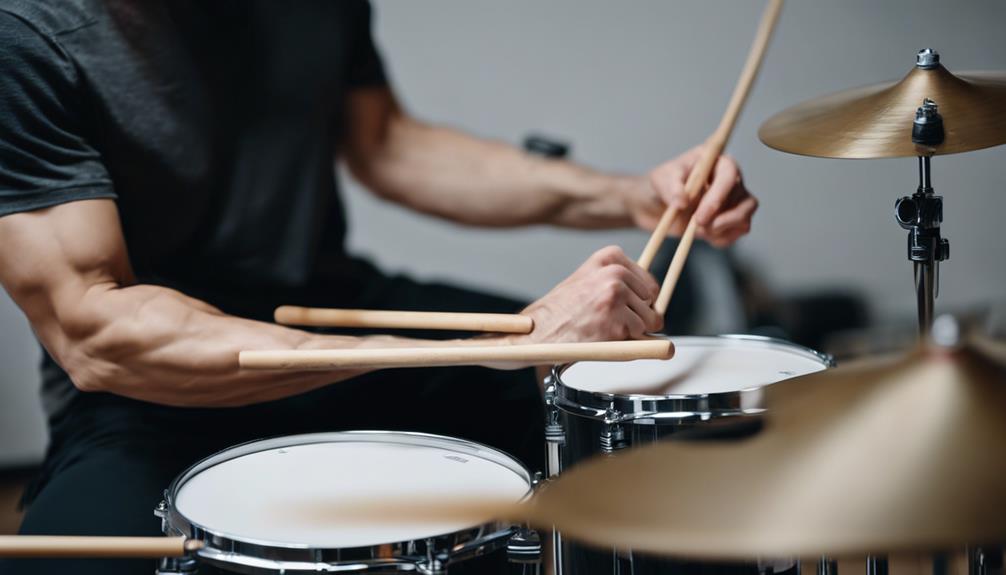When you’re behind the drum kit, preventing injuries is essential to maintain your playing longevity and overall health. Start by focusing on proper technique and making sure you have the correct grip, as this can greatly reduce strain on your muscles. Incorporate warm-up exercises and stretching routines to prepare your body for the physical demands of drumming. It’s also vital to listen to your body’s signals and take appropriate breaks. But how do you guarantee you’re doing everything right to avoid common pitfalls? Let’s explore the specific steps you can take to safeguard your drumming experience.
TL-DR
- Maintain proper posture and ergonomic drum setup to minimize muscle tension.
- Incorporate dynamic and static stretches for wrists, forearms, shoulders, and back.
- Schedule regular breaks and prioritize rest and recovery to prevent muscle fatigue.
- Use correct wrist and grip techniques to avoid repetitive strain injuries.
- Gradually increase practice intensity to adapt muscles and reduce injury risks.
Proper Technique

Mastering proper drumming technique is vital to prevent injuries and promote longevity in your drumming career. When you play, it’s essential to use your fingers, wrists, and forearms efficiently to power your stick movements. This not only helps you maintain control but also prevents strain on your muscles and tendons.
Your posture plays a significant role in how you feel after long sessions. Always sit up straight, and keep your back relaxed yet supported. Avoid slouching, as this can lead to back pain and muscle strains over time. Proper posture ensures you distribute your weight evenly, reducing the risk of injury.
Foot pedals can be another source of strain if not used correctly. Techniques like heel-down and heel-up require specific leg movements. With the heel-down technique, your leg remains stationary, reducing strain on your ankle.
The heel-up technique, however, involves more movement and power from your thigh, which can be taxing without proper form. Pay attention to how your legs and feet interact with the pedals to avoid pain and injuries.
Correct Grip
When it comes to drumming, your grip matters more than you might think.
By maintaining proper grip pressure, ensuring correct wrist and arm alignment, and mastering finger techniques, you can greatly reduce the risk of injury.
Let’s explore how these factors can keep your hands and arms pain-free.
Proper Grip Pressure
Proper grip pressure is essential to avoid thumb joint pain and finger soreness while drumming. The way you grip your drumsticks can greatly impact your comfort and longevity in playing. It’s important to strike a balance—too tight a grip increases muscle tension, leading to discomfort and potential injury. Instead, maintain a relaxed grip that allows for flexibility and movement.
Adjusting your grip pressure based on the style of drumming you’re performing can make a big impact. For instance, lighter styles may benefit from a looser grip, while more intense drumming might require a slightly firmer hold. However, always avoid clenching the drumsticks. A tight grip not only causes wrist pain but can also lead to finger soreness.
Changing grips occasionally helps distribute pressure evenly across your hands, reducing the risk of repetitive strain injuries.
Pay attention to how your fingers and thumbs feel as you play. If you notice any pain or stiffness, it’s a sign to reassess your grip pressure and make necessary adjustments.
Wrist and Arm Alignment
Guaranteeing proper wrist and arm alignment is essential for preventing injuries and maximizing performance while drumming. When you pay attention to your grip, it greatly reduces the chances of wrist pain and muscle strain.
Here’s how you can achieve proper hand positioning and alignment:
- Choose the Right Grip: Decide between the traditional grip and match grip. Both have their unique benefits, but make sure you’re comfortable and your wrists and arms are naturally aligned.
- Maintain a Neutral Wrist Position: Keep your wrists straight and avoid excessive bending. This helps distribute the stress evenly and prevents wrist pain.
- Balance Power Distribution: Use your fingers, wrists, and forearms together. This balanced approach prevents muscle strain by ensuring no single muscle group is overworked.
- Check Your Hand Positioning: Ensure your hands aren’t too far up or down the drumsticks. Proper hand positioning helps in maintaining control and reduces the risk of injuries.
Finger Technique Mastery
Building on wrist and arm alignment, mastering finger technique with the correct grip is essential for injury prevention and improved control. Start by confirming you have a proper grip that’s neither too tight nor too loose. A grip that’s too tight can lead to thumb joint pain and soreness in your index finger, while a loose grip won’t give you the control you need.
Focus on finger technique mastery by using a combination of your fingers, wrists, and forearms to power the stick. This approach helps distribute the workload evenly, reducing the risk of aches and pains. For instance, alternating between different grips can be advantageous. It allows you to shift the stress from one part of your hand to another, minimizing the likelihood of overuse injuries.
Always warm up before you play. Loosening up your fingers, wrists, and forearms ensures a more fluid and controlled drumming experience, which is essential for preventing wrist pain. Simple exercises like finger stretches and wrist rotations can make a significant difference.
Regular Grip Changes

Switching up your grip regularly can greatly reduce the risk of drumming injuries by distributing the strain across different muscle groups. When you consistently alter your grip technique, you prevent overuse of specific muscles, promoting muscle balance and reducing fatigue. This approach not only helps in preventing drumming injuries but also enhances your overall performance.
Here are some key points to take into account:
- Varied Grip Styles: Switching between traditional grip and matched grip can distribute the workload across different muscle groups, preventing strain and promoting flexibility.
- Muscle Engagement: Different grip styles engage distinct fingers and wrist movements, which helps maintain muscle balance and improve coordination.
- Enhanced Dexterity: Incorporating grip changes into your practice routine can boost hand dexterity and strength, making you a more versatile drummer.
- Injury Prevention: By challenging your muscles in new ways with different grip techniques, you minimize the risk of overuse injuries, ensuring a longer, healthier drumming career.
Regularly changing your grip technique is a simple yet effective strategy. It guarantees that no single muscle group bears too much strain, thereby maintaining muscle balance and reducing the likelihood of drumming injuries. Implementing these grip variations into your daily practice can make a significant difference in your drumming experience.
Warm-Up Exercises
Warming up before drumming is essential to prepare your muscles and joints for the physical demands ahead. A proper warm-up routine can make a significant difference in your drumming performance and help prevent injuries.
Start with dynamic stretches that target your wrists, fingers, and arms. For example, wrist rotations and arm swings are great for improving blood flow and flexibility. These movements will help loosen up your muscles, making them more pliable and ready for the rigors of drumming.
Gradually increase the intensity of your warm-up. Begin with slow, controlled movements and progressively build up to more vigorous exercises. This gradual approach helps prevent sudden strains or injuries that can occur when you dive straight into intense drumming. Focus on loosening up your fingers, wrists, and arms, as these areas are particularly prone to strain.
A well-rounded warm-up routine doesn’t just prevent injuries; it also improves your drumming technique. When your muscles are properly warmed up, you’re less likely to experience muscle fatigue, allowing you to play longer and with greater precision.
Incorporating these warm-up exercises into your daily practice can enhance your overall playing experience and keep you injury-free.
Stretching Routines

You need to incorporate stretching routines into your practice to prevent injuries and improve your performance. Start with dynamic stretches before drumming to enhance flexibility, and finish with static stretches after to aid muscle recovery.
Don’t forget to focus on your wrists, forearms, shoulders, and back to keep everything balanced and ready for action.
Warm-Up Exercises
Incorporate wrist circles, arm stretches, and finger flexion exercises into your warm-up routine to prevent drumming injuries. These warm-up exercises are essential to preparing the specific muscle groups you use while drumming. By focusing on your wrists, forearms, and shoulders, you can reduce the risk of injury and enhance your performance.
Start with dynamic stretching to improve blood flow and flexibility in your muscles. This can be done through exercises like:
- Wrist Circles: Rotate your wrists in both clockwise and counterclockwise directions. Do about 10 rotations each way.
- Arm Stretches: Extend one arm straight out in front, then use the opposite hand to gently pull your fingers back, stretching the forearm. Hold for 15 seconds and switch arms.
- Finger Flexion Exercises: Flex and extend your fingers repeatedly for a minute. This helps in warming up the smaller muscles in your hands.
- Shoulder Rolls: Roll your shoulders forward and backward in a circular motion. Perform 10 rolls in each direction.
Gradually increase the intensity of these exercises to prepare your body for the physical demands of drumming. Consistent warm-up routines can prevent strains, muscle imbalances, and overuse injuries, ensuring you can drum comfortably and safely.
Flexibility Improvement
To enhance your drumming flexibility and prevent injuries, introduce a variety of targeted stretching routines into your practice. Regular stretching can greatly boost your range of motion and reduce the risk of muscle strains.
Start with dynamic stretching before your drumming sessions to get your muscles warmed up and increase blood flow. Dynamic stretches, such as arm circles and wrist rotations, are essential for preparing the wrist, forearm, shoulder, and back muscles for the physical demands of drumming.
Focus on stretches that specifically target these areas. For instance, wrist flexor and extensor stretches can help maintain flexibility and prevent tension-related injuries. Forearm stretches, such as the prayer stretch, are also beneficial.
Shoulder and back stretches, like shoulder rolls and upper back stretches, can alleviate tightness and improve your overall drumming posture.
Incorporating these stretching routines into your practice not only helps in preventing injuries but also enhances your drumming performance. Consistent flexibility improvement makes it easier to execute complex drumming patterns and maintain endurance during long sessions.
Post-Drumming Stretches
After a drumming session, it’s important to engage in post-drumming stretches to prevent muscle stiffness and enhance flexibility. Stretching not only helps you recover faster but also reduces the risk of injuries.
Here are some effective post-drumming stretches to incorporate into your routine:
- Wrist Flexor Stretches: To prevent wrist injuries, extend your arm with your palm facing up, then gently pull back your fingers with your other hand until you feel a stretch in your wrist and forearm. Hold for 20-30 seconds.
- Shoulder Stretches: Relieve shoulder tension by crossing one arm over your chest and using your other arm to press it closer to your body. This stretch helps alleviate any tightness and prevents shoulder issues.
- Calf Stretches: If you use foot pedals extensively, stretch your calves by standing with one foot forward and the other back. Lean into a wall, keeping your back heel on the ground, and hold for 20-30 seconds.
- Back Stretches: Prevent backaches by sitting on the floor with your legs extended. Reach forward towards your toes, keeping your back straight, until you feel a stretch in your lower back.
Including these post-drumming stretches in your routine can make a significant difference in your overall drumming health.
Cooling Down
Cooling down after drumming sessions greatly helps in preventing muscle stiffness and soreness. By gradually lowering your heart rate and promoting blood flow, cooling down is vital for muscle recovery. This practice also helps reduce tension in your muscles, which is important after an intense drumming workout.
Start your cool down with gentle stretching exercises. These movements will aid in muscle recovery and improve your flexibility. Focus on slowly stretching your arms, shoulders, and back—areas that are heavily used during drumming. This can greatly reduce the risk of cramping and injuries.
Incorporate breathing exercises into your cooling down routine. Deep, controlled breaths can promote relaxation and help reduce tension in your muscles. Pair these with gentle movements to further enhance muscle relaxation and ensure a smoother shift from drumming to rest.
Don’t skip the cool-down phase, even if you’re in a hurry. Proper cooling down techniques aren’t just about preventing immediate discomfort; they also contribute to your long-term muscle health and overall performance. By dedicating just a few minutes to cooling down, you can guarantee faster recovery times and maintain a higher level of drumming endurance.
Adequate Rest

While cooling down is essential, ensuring you get adequate rest is equally important in preventing drumming injuries. Rest allows your muscles to recover and reduces the risk of overuse injuries. When you don’t rest enough, you increase the chances of fatigue, which can lead to poor technique and a higher likelihood of strains and injuries.
To make sure you’re getting the rest you need, consider the following steps:
- Schedule Regular Breaks: During practice sessions, take short breaks every 30 minutes to prevent muscle fatigue and maintain good technique.
- Rest Between Gigs: Make sure you have sufficient rest between performances to allow your muscles to recover fully.
- Listen to Your Body: If you feel unusually tired or sore, it’s a sign that you need more rest.
- Prioritize Sleep: Quality sleep is essential for muscle recovery and overall performance.
Listen to Your Body
Recognizing and responding to your body’s signals is vital for preventing drumming injuries. Pay close attention to any discomfort, pain, or particularly shoulder tension while you’re playing. If you feel any strain, don’t ignore it. Taking breaks when needed can help you avoid overexertion and prevent injuries. Over time, continuous playing without rest can lead to chronic issues, so listen to your body and give it the downtime it needs.
Adjusting your technique or posture is essential when you notice discomfort. Sometimes, a small tweak in how you hold your sticks or sit can make a big difference. Make sure you’re not slouching or putting undue stress on your muscles. Regularly stretching and warming up before drumming prepares your muscles and joints, reducing the risk of strain and injury.
Staying hydrated and maintaining a healthy lifestyle also play a significant role in your body’s ability to handle the physical demands of drumming. Proper hydration keeps your muscles functioning at their best, while a balanced diet supports overall resilience.
Wrist Pain Prevention

Proper warm-up routines are essential for preventing wrist pain in drummers. To reduce the risk of drumming injuries, start by loosening up your wrists before playing. This preparation helps your muscles and joints get ready for the intense activity ahead, minimizing strain and discomfort.
Here are four steps to help you prevent wrist pain effectively:
- Stretch Your Wrists: Take a few minutes to stretch your wrists gently. Flex and extend your wrists, and rotate them in circular motions to increase flexibility and blood flow.
- Avoid Tight Grips: Holding your drumsticks too tightly can lead to thumb joint pain and unnecessary stress on your wrists. Instead, maintain a relaxed grip to promote fluid movements.
- Strengthening Exercises: Incorporate exercises that target wrist strength. Simple weightlifting or resistance band exercises can enhance your wrist’s resilience, making it easier to handle long drumming sessions.
- Proper Technique: Focus on using the correct wrist movements while drumming. Poor technique can lead to repetitive strain injuries, so make sure your strokes are smooth and controlled.
Tendonitis Avoidance
To further protect your wrists, it’s important to address tendonitis caused by repetitive motions and overuse. Drumming can be physically demanding, and tendonitis often results from the constant strain on the muscles in your wrist and forearm.
To combat this, gradually increase your practice intensity rather than diving into long, strenuous sessions right away. This helps your muscles adapt and reduces the risk of tendonitis injuries.
Incorporate regular rest breaks into your drumming routine to give your tendons time to recover. Additionally, essential warm-up routines and stretching exercises are vital. Spend a few minutes before each session doing wrist and forearm stretches to increase flexibility and blood flow, which can significantly lower the chances of developing tendonitis.
Consider seeking guidance from a professional drumming instructor. They can help you identify and correct any techniques that might contribute to tendonitis. Often, small adjustments in how you hold your drumsticks or position your hands can make a big difference.
Muscle Strain Reduction

To reduce muscle strain while drumming, it is important to start with proper warm-up techniques to prepare your muscles.
Make sure your drum setup is ergonomic to prevent unnecessary strain.
Regular stretching routines will keep your muscles flexible and less prone to injuries.
Proper Warm-Up Techniques
Warming up with specific exercises like wrist rotations and finger stretches can greatly reduce your risk of muscle strain while drumming. Proper warm-up techniques are essential to prepare your muscles and improve blood flow, ensuring you perform at your best without injury.
Here are some targeted drumming exercises to incorporate into your routine:
- Wrist Rotations: Rotate your wrists in circular motions, first clockwise and then counterclockwise. This helps to loosen up the wrist joints and prevent muscle strain.
- Finger Stretches: Extend and flex each finger, holding each stretch for a few seconds. This enhances flexibility and reduces the risk of muscle strain in your fingers.
- Arm Movements: Swing your arms gently in circles and side-to-side. This warms up your shoulder and arm muscles, preparing them for more intense drumming movements.
- Gradual Tempo Increase: Start your practice session with slow, light drumming exercises and gradually increase the tempo and intensity. This progressive approach boosts blood flow and muscle readiness.
Consistent warm-up routines are vital for preventing injuries. By integrating these exercises into your pre-drumming ritual, you’ll not only enhance your performance but also safeguard your muscles from unnecessary strain.
Ergonomic Drum Setup
After warming up, an ideal drum setup is crucial to reducing muscle strain and preventing injuries. Position your drums as an extension of your body for maximum comfort and efficiency. Start by ensuring your legs are evenly spaced and your feet rest comfortably on the pedals. This helps avoid unnecessary muscle tension and promotes a more relaxed playing style.
Make sure your hips are higher than your knees. This position prevents lower back strain and allows for better balance and control. Adjust your seat height until you find that perfect spot where your hips maintain this higher position.
Additionally, position your ankle slightly in front of your knee. This setup makes it easier to flex back and reduces strain on your leg muscles during those intense drumming sessions.
Regular Stretching Routines
Incorporating regular stretching routines into your practice sessions can greatly reduce muscle strain and tension. Stretching before and after drumming not only improves flexibility but also helps prevent common drumming injuries. By targeting specific areas like your wrists, forearms, shoulders, and back, you can notably lower the risk of muscle strain.
Here’s how to effectively include stretching in your drumming routine:
- Wrist Stretches: Extend one arm straight in front of you, palm down. Use your other hand to gently pull back your fingers. Hold for 15-30 seconds and switch sides.
- Forearm Stretches: Extend one arm in front, palm up. Gently pull back your fingers with the opposite hand. Hold for 15-30 seconds and switch sides.
- Shoulder Stretches: Bring one arm across your body and use the opposite arm to press it towards your chest. Hold for 15-30 seconds and switch sides.
- Back Stretches: Sit or stand and gently twist your torso to one side, holding the position for 15-30 seconds. Repeat on the other side.
Incorporating yoga or Pilates can also enhance your flexibility and further prevent muscle strain. Consistent stretching improves blood flow, reduces muscle fatigue, and enhances your overall performance while drumming. Don’t underestimate the power of stretching routines in keeping you injury-free and at your best.
Hearing Protection
Ensuring your hearing while drumming is vital to prevent long-term damage from high volumes. As a drummer, you’re constantly exposed to loud music, which puts you at a higher risk for hearing damage. Effective hearing protection is essential to safeguard your ears from the harmful effects of prolonged exposure to intense sounds.
Using earplugs or noise-canceling headphones can greatly reduce the risk of hearing loss. High-quality earplugs are designed to lower the volume without distorting the sound, allowing you to enjoy your music while keeping your hearing safe. Noise-canceling headphones are another excellent option, as they help to block out background noise and reduce overall sound levels.
Regular hearing check-ups are also important for musicians. These check-ups can help you monitor any changes in your hearing health and catch any potential issues early. If you notice any signs of hearing loss, such as ringing in your ears or difficulty hearing high-pitched sounds, don’t ignore them. Addressing these symptoms promptly can prevent further damage.
Incorporating these hearing protection strategies into your drumming routine will help ensure that your passion for music doesn’t come at the expense of your long-term hearing health.
Shoulder Care

To protect your shoulders while drumming, you need to focus on proper stretching techniques and strengthening shoulder muscles.
Stretching helps maintain flexibility and prevents stiffness, while strengthening guarantees your shoulders can handle the physical demands.
Proper Stretching Techniques
Regularly stretching your shoulders before drumming boosts flexibility and helps prevent injuries. Shoulder stretches are vital for preparing your muscles for the physical demands of drumming. By incorporating a few simple stretches into your warm-up routine, you can enhance your performance and greatly reduce the risk of common drumming injuries like impingement syndrome.
Here are some effective shoulder stretching techniques:
- Cross-Body Shoulder Stretch: Extend one arm across your body and use your opposite hand to gently pull your elbow toward your chest. Hold for 20-30 seconds, then switch arms.
- Shoulder Circles: Stand with your feet shoulder-width apart and make small circles with your shoulders, gradually increasing the size. Perform this for 30 seconds in each direction.
- Doorway Stretch: Place your hands on either side of a doorway at shoulder height, then step forward until you feel a stretch in your chest and shoulders. Hold for 20-30 seconds.
- Triceps Stretch: Raise one arm overhead, bend the elbow, and use your other hand to gently push the elbow back. Hold for 20-30 seconds, then switch arms.
Consistent shoulder stretching increases blood flow, improves posture, and reduces muscle tension, ensuring a more enjoyable and injury-free drumming experience.
Strengthening Shoulder Muscles
Developing strong shoulder muscles is essential for maintaining stability and avoiding common drumming injuries. By focusing on shoulder strength training, you can greatly reduce the risk of impingement syndrome, a common issue among drummers.
Strong shoulder muscles not only enhance your drumming performance but also alleviate strain on your joints, making your sessions more comfortable and efficient.
To start, target your rotator cuff muscles with specific exercises like external rotations and shoulder presses. These moves are important for enhancing shoulder stability and preventing overuse injuries that can sideline your practice.
Incorporate these exercises into your regular routine to build resilience and support your drumming demands.
Proper shoulder strength training also plays a crucial role in maintaining good posture and technique. When your shoulder muscles are strong, you can hold your sticks correctly, facilitating better control and reducing the risk of injury.
This translates to more endurance and precision during long practice sessions or performances.
Back Pain Relief
Maintaining good posture while drumming is essential to preventing back pain and muscle strain. Proper posture guarantees that your spine is aligned and supported, reducing the risk of muscle strain and chronic back pain.
To achieve this, you’ll need to set up your drum kit ergonomically, making it an extension of your body.
Here are some key steps to follow:
- Ergonomic Setup: Adjust your drum kit so that everything is within easy reach. This minimizes unnecessary stretching and twisting that can strain your back muscles.
- Hip Positioning: Ensure your hips are higher than your knees. This posture helps to reduce lower back strain and allows for better balance.
- Foot Placement: Keep your feet comfortably positioned with your ankles slightly in front of your knees. This setup provides easier flexing of your back and prevents lower back pain.
- Posture and Shoulders: Avoid slouching by keeping your back straight and your shoulders relaxed. A slouched posture can lead to backaches and muscle strain over time.
Leg and Knee Health

Maintaining proper foot pedal technique and positioning is crucial for protecting your legs and knees while drumming. Begin by adjusting your drum throne height to maintain a comfortable and supportive position. Your knees should be at a slight downward angle, not too high or too low, which helps enhance your leg and knee health.
Balance your use of heel-down and heel-up techniques. Heel-down is great for softer dynamics and helps reduce strain on your lower legs, while heel-up provides more power but can be tougher on your knees. Utilizing a mix of both ensures you don’t overexert any specific muscles or joints.
Keep in mind, drumming ergonomics play a significant role. Position your pedals so that your legs can move naturally without unnecessary twisting or reaching. Avoid overextending your legs, as this can lead to strain and potential injury.
Incorporate regular stretching and strengthening exercises into your routine. Stretching your calves, hamstrings, and quadriceps can enhance flexibility, while strengthening exercises like leg lifts or squats can support your knee joints. By focusing on these aspects, you’ll improve your overall drumming performance and longevity, keeping your legs and knees healthy for years to come.
Next up learn how to correctly hold drum sticks in this guide.
